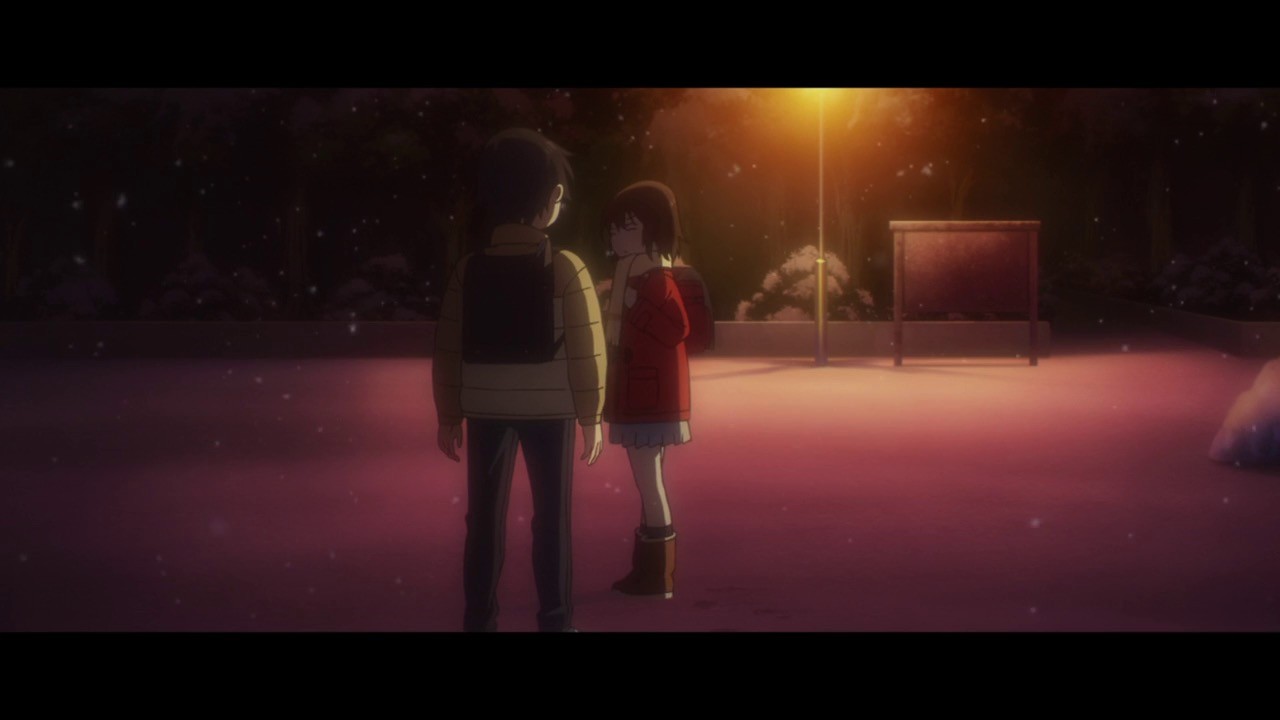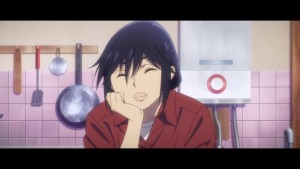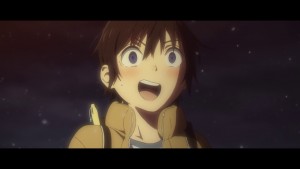My word – that was pretty breathtaking stuff.
Boku Dake ga Inai Machi is both a very easy and incredibly difficult series for me to write about. Not only is it utterly fantastic, but it’s ridiculously deep and subtle, operating on a level where anime almost never goes. But it’s also awfully hard not to gush like a smitten schoolgirl when an episode is as flawless as this one, especially when it’s an adaptation of a manga that was already dear to your heart. And then there’s the fact that there’s just so much I want to talk about, but can’t – and that’s exquisite torture.
I can’t and won’t gloss over my opinion that this is a great, great show – the manga is a rare gem to begin with, but thank goodness A-1 Pictures understands that they have such a gem (as they usually do) and are treating it with the respect it deserves. I mean, I knew how great the manga was and I was still totally blown away by the first two eps (and this one was even better than the premiere). Both the OP and ED are terrific visually and musically, and fit the material like a glove. And the wonderful Kajiura Yuki’s background music is used tastefully and effectively by Ito Tomohiko. The visuals are utterly beautiful (as they were the last time A-1 adapted an anime with a similar visual style for NoitaminA, Hourou Musuko) and Ito’s use of the camera is consistently riveting.
It’s rare indeed that a manga this good gets an adaptation this good, so we should really count our blessings here. The news came this week that the manga will be ending in the spring, and Ito will be using Sanbe Kei’s ending, which I see as something of a mixed blessing. It is nice that the anime will get the ending that the author intended, but I’m rather sad to see it concluded so soon. And knowing now that Ito needs to compress the entire story into 12 episodes, I can’t help but be a little anxious over what the pacing will be like down the line. These are worries – different worries than we had before the news came out, but worries nonetheless.
We know the road we’re on is going to have that bridge eventually, then, but it’s going to take some time to get there and my God, what a trip it’ll be. Trust me, this story just gets better (hard as that may be to believe now). This episode does so many things not just right but exactly right that it’s hard to know just where to begin. One could single out moments of directorial flair, like Ito’s decision to leave the adult Satoru’s voice inside the child Satoru’s head – and to have both voices overlay each other at critical junctures. Or subtle touches like Sachiko’s hand counting out something as we watch him lie next to her on his futon. Or the way the casting suits the characters so perfectly – which is never a given, most especially when children are the center of the story.
This is where we wade into dangerous waters for me, because with Boku Dake it’s hard to talk about the past without talking about the future. But I will say that of all the things I find remarkable about this series – and it’s even more powerful with the characters brought to life – perhaps most striking of all is the sheer volume of emotional power it can pack into a single moment, often with little dialogue. We saw last week the difficult relationship the adult Satoru had with his mother – now we see that beneath that, he still loves her unreservedly. There’s such a quiet beauty to those first moments when the 10 year-old Satoru is reunited with Sachiko – the adult inside the body of a child, a grown man feeling the unvarnished love of a boy for his parent, perhaps for the first time in years. That was as good as any scene in anime this year, and I won’t be surprised if that’s still true in December – or rather, I wouldn’t be surprised if I didn’t know we had ten more episodes of Boku Dake to come.
Then we have Satoru’s moments at school, the sublime awkwardness he feels at being back in the world of a ten year-old boy. Again it’s communicated so artfully both by Ito and Sanbe that it truly feels as if we’re right in that classroom with him. We meet Satoru’s circle of friends for the first time – there’s the clever and quiet Kenya (Taichi You), the boisterous Kazu (Kikuchi Yukitoshi), the innocent Osamu (Nanase Ayaka), and the feminine-looking Hiromi (Kito Akari). Each is important, and one thing we pick up on is that these friends are very important to the young Satoru – though perhaps that was something his adult self had forgotten about.
Then of course there’s Hinadzuki Kayo (Aoi Yuuki), whose importance to the story has already been made clear. Hiadzuki is a tragic figure even before the events the adult Satoru knows are to follow – a lonely girl clearly being abused, who cries out in the wilderness through her 5th-grade essay. Satoru has a vested interest in Kayo of course, which his pals take for a schoolboy crush. The final scene of the episode rivals the reunion between Satoru and Sachiko for sheer brilliance and emotional heft – Tsuchiya Tao and the superb Aoi nail every moment. Again we see the awkwardness of and for Satoru – this is an incredibly uncomfortable thing for a ten year-old boy to begin with, and the 29 year-old inside him feels every last atom of embarrassment crashing over him like a tidal wave. But it’s a beautiful moment too, when viewed from a distance through the falling Hokkaido snow.
At the risk of sounding too ebullient, I must reiterate – this is the kind of stuff we just don’t see in anime very often, period. Material this profound and polished hardly ever comes along to begin with and when it does, it’s rarely deemed to be commercial enough for anime. And when you’ve somehow hit the first five numbers, you still have to nail the powerball – you still need an adaptation that lives up to the brilliance of the source material. I didn’t win $1.6 billion in the lottery, but in anime terms getting Boku Dake ga Inai Machi is a burst of good fortune almost as unlikely.







